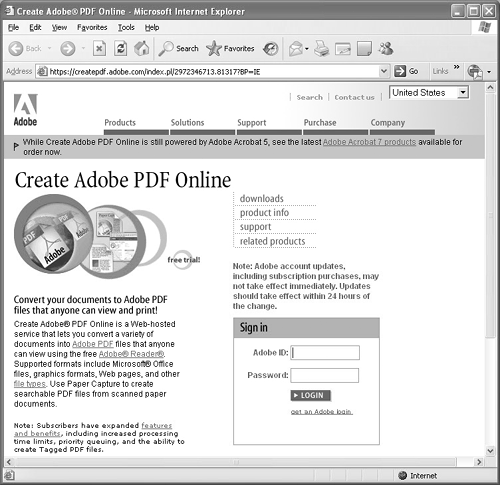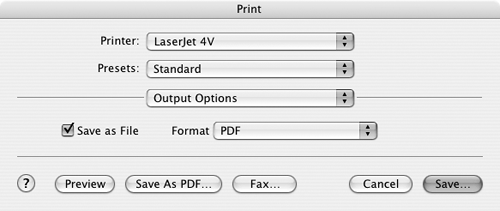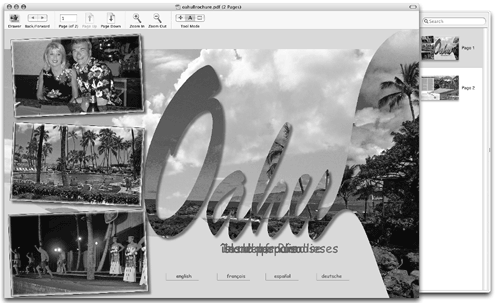Adobe Reader is used after a PDF file has been created. As you know, you can't create PDF documents from Adobe Reader. So does that mean you have to completely rely on other users to create PDF files you work with in Reader? Are you doomed to be at the mercy of PDF authors forever? Like everything else in the computer world the answer is, it depends.
If you are a Macintosh user, you're in luck. You don't need to run out and buy a software program to be able to create many different types of PDF documents. You can create PDF files from applications installed with your OS X Panther software in many ways using several system tools.
If you're a Windows user, either you need to download a free application from a third-party developer, or you must buy an application. The kind of program you need can be freeware or shareware that converts application documents to PDF—or some other low-cost app for creating PDFs. Your other alternative is to pay a service that will convert most document files to PDF on a per-document basis.
For both Windows and Macintosh users, Adobe provides you with a solution for creating PDF files using many different authoring programs. The Adobe Reader Toolbar Well displays different buttons that appear in a revolving banner in the top-right corner of the Toolbar Well. One of those buttons is the Create Adobe PDF Online button (Figure A.1).
Figure A.1. The Create Adobe PDF Online button is a link to Adobe's Web site, where you can find information about using Adobe's online services for creating PDF files.
You can either click this button (if it's in view) or select File > Create Adobe PDF Online; your default Web browser launches. Either selection takes you to the Create Adobe PDF Online Web page (Figure A.2). Here you'll find information about having Adobe Systems convert your document to PDF.

Figure A.2. The Create Adobe PDF Online Web page contains information about submitting files for PDF conversion online.
Click the link for file types and a Web page opens showing you file formats acceptable to upload to the Adobe Web site. Files such as Microsoft Office, Autodesk AutoCAD, Adobe imaging program documents, Corel WordPerfect Office formats, PostScript files, and text files are some of the file types you can upload. For a monthly or annual subscription fee, this online service lets you convert a few or several files without having to buy a PDF creation utility. You upload files to the service, which then sends the converted files back to you in PDF format via Adobe's Web server.
When you open the Web page, you can click a link to set up an account and receive the first five conversions free to test the service. After submitting the first five files, you submit additional files on a subscription basis.
A number of application software programs support conversion to PDF. Because PDF conversion is handled within an application, the files you convert apply only to files you can open in the program that supports PDF creation. At the high end of software products, programs like CorelDraw, Adobe PageMaker, Adobe InDesign, Adobe Photoshop, Adobe Illustrator, and QuarkXPress all support document conversion to PDF. The low-cost, consumer-grade products that support PDF conversion are generally distributed by Adobe Systems. The two most common are Adobe Photoshop Elements and Adobe Photoshop Album.
Adobe Photoshop Elements is an image-editing program and the junior cousin of Adobe Photoshop. You can purchase Adobe Photoshop Elements either as a stand-alone product or as a companion product with Adobe Premiere Elements.
Note
You can download tryout versions for all Adobe software from Adobe's Web site. Open www.adobe.com/products in your Web browser and click the links for the products that interest you. On each product description page, you'll find links to download free tryout versions.
Adobe Photoshop Elements is commonly used for editing photographs and creating Web graphics. If you have digital or scanned photos you want to edit, or if you want to create buttons and icons for Web graphics, Photoshop Elements may be just the program for you. Priced at just under U.S.$100, Photoshop Elements provides you with tools to edit scanned images and digital photographs with a power that comes close to that of Adobe Photoshop. Obviously, not all features found in Photoshop are available in Photoshop Elements, but the program satisfies the needs of many consumer and professional users.
Note
As of this writing, Photoshop Elements can be purchased as a single product (U.S.$99.95) or bundled with Adobe Premiere Elements (U.S.$149).
With Photoshop Elements you can save directly to a PDF format. You can convert all screen captures to PDF files, and you can convert a folder of photo images to a PDF slide presentation. You can also open multipage PDF documents and convert them to image files saved as JPEG, TIFF, and a number of other image file formats.
Adobe Photoshop Album is a photo image organizer and a tool for transforming, editing, and sharing photo images, and it's available in Windows only. You can create slide presentations complete with sound and video, and export your creations to Adobe PDF. Photoshop Album is a fun product that offers you many options for creating slides with transition effects, creating postcards, importing video and sound, and burning your creations to CD-ROMs or DVDs. At a price of less than U.S.$50, Photoshop Album is a bargain.
The Adobe Acrobat family of products was first introduced in 1993; and since the beginning of Acrobat's history, all products were supported in Windows and on the Macintosh, as well as few other operating systems. During the more than decade of development, the Acrobat products favored Windows users with more tools to produce PDF documents. Adobe Reader was virtually the same on all platforms, but the Windows Acrobat users generally had a few more features to work with than their Mac counterparts.
When Apple Computer introduced the Macintosh OS X operating system, the game changed. At the core of the Mac operating system is support for PDF. Often, to the dismay of many graphic designers who communicate with their Windows clients, Mac users think that what they have available on their computers is available to everyone: “Just send me a PDF document—go to the print dialog and save the file as a PDF.” Windows users, who are typically frustrated and baffled, thinking the ad agency people must know what they're talking about, poke around trying to find the command that converts a Microsoft Office file to PDF. Well, Mac users, be aware: What you see available to you on Mac OS X is not necessarily available to Windows users.
On Macintosh OS X Panther, there are a number of ways to convert EVERY application document to PDF.
To convert a document to PDF, open any program on the Macintosh and select File > Print. In the Print dialog select a PostScript printer from the Printer pull-down menu. Although selecting a PostScript printer isn't mandatory, you get much better results when using a PostScript printer.
Below the Presets pull-down menu, you'll see another pull-down menu. Open the menu and select Output Options. The Print dialog changes (Figure A.3). Click Save As PDF, and the Save to File dialog opens. Alternatively, you can check the Save as File check box and click the Save button. Navigate your hard drive and locate a target folder. Name the file and click Save. The file is saved as PDF and can be opened in Adobe Reader.

Figure A.3. Select Output Options and click Save As PDF or check Save as File and click Save to create a PDF document from any program.
Regardless of the program you use, if you can open the Print dialog, you can save your document as a PDF file.
Note
You can convert Web pages to PDF using the Save As PDF feature in the Print dialog in both Apple Safari and Microsoft Internet Explorer. The one limitation you have when using the Print dialog to create PDF files is that any Flash animation contained on Web pages is not visible in the resultant PDF document. Users of Acrobat Standard and Acrobat Professional can use a Web Capture feature that converts Web pages to PDF complete with animation effects.
A screen shot is a snapshot of what you see on your computer monitor. Using the Macintosh OS X operating system keyboard shortcuts, you can take a snapshot of the entire monitor screen, a section of the screen, a dialog, a menu, an icon, a window, or the Dock. All the screen shots you take are saved on your Desktop as PDF files. When you take a screen shot, the files are named Picture 1, Picture 2, Picture 3, and so on.
To take a snapshot of:
The monitor screen. Press Command+Shift+3 to capture the monitor screen in its entirety.
One section of the monitor screen. Press Command+Shift+4. The cursor changes to a crosshairs. Click and drag a rectangle around the area of the screen you want to capture. When you release the mouse button, the selection is saved as PDF.
An object (window, menu, icon, dialog). Press Command+Shift+4. Instead of dragging with the mouse, press the spacebar immediately after pressing the modifier keys. Your cursor changes to a camera icon. Click the mouse button on the object you want to capture. Your screen capture is saved to PDF. If you want to capture the Dock, use the same keys plus the spacebar and click when the cursor is positioned between the programs shown in the Dock.
Preview is a stand-alone program included with your OS X operating system. Preview is like Adobe Reader in many ways—you can view PDF documents, zoom in and out of pages, search and find text, and use viewing options similar to Adobe Reader's. Figure A.4 shows a PDF document opened in Preview with the Drawer open. (Note the Drawer tool in the top-left corner of the top-level toolbar and the Drawer pane open on the right side of the document page. Clicking the Drawer tool opens the Drawer pane.) The page thumbnails shown in the Drawer pane are similar to thumbnails in the Pages pane in Adobe Reader.

Figure A.4. Open the Drawer in Preview to see page thumbnails of PDF pages, much like you do in Adobe Reader's Pages pane.
The one advantage Preview has over Adobe Reader is that whatever you open in Preview can be saved as a PDF file. You can open a PDF document, an image file, or a text file. Choose File > Export after opening in Preview. The Save As dialog opens, where you can select PDF from the Format pull-down menu (Figure A.5). Click Save and the file is saved as PDF.
A limitation in Preview is that you can't combine documents into a single file. If, for example, you have a number of images saved as different files, you can't combine all the images on separate pages in Preview and export to PDF.
Tip
Between Preview and Save As PDF, you have a number of workarounds you can use to create PDF files. If you want to combine images or text from separate files, open TextEdit (also installed with your Macintosh OS X operating system). Import images and/or text in TextEdit. Select File > Print and select Save As PDF. (TextEdit also supports importing PDF documents.)
Anything you copy to the system clipboard can be converted to PDF using Preview. You can copy buttons, icons, text passages, image data, or portions of PDF documents, and convert the copied data to a PDF file.
After copying data to the clipboard, open Preview. Select File > New From Clipboard. The data on the system clipboard opens as a new document in Preview. Select File > Export and choose PDF for the file format. Save the file and you can open it in Adobe Reader.
Using the clipboard data with Preview offers you, among other things, many options for creating PDF files you can use for Digital ID appearances and for creating custom stamps in Adobe Reader. For more information on creating appearances with Digital IDs, see Chapter 17, “Using Digital Signatures and Security.” For more information on creating custom stamps, see Chapter 12, “Working with Stamp Comments.”
Adobe LiveCycle Reader Extensions Server (ARES) is not a PDF creation tool. Rather, the product is used to add more functionality when working with PDFs in Adobe Reader. Adobe LiveCycle Reader Extensions is not the kind of product you as an end user of Adobe Reader would purchase. The cost is prohibitive for single users. However, for enterprises, government offices, educational institutions, and large businesses, the features the server software provides are very cost-effective.
The Adobe LiveCycle Reader Extensions allows large enterprises and other such entities to create and share dynamic PDF documents among co-workers, constituents, and clients. LiveCycle Reader Extensions enables organizations to extend PDFs on a document-by-document basis for Reader users to comment on and annotate files, fill-in and save forms, and add digital signatures to forms. Prices for the Adobe LiveCycle Reader Extensions Server start in the tens of thousands of dollars, so end users wouldn't purchase the software. But it does make sense for large companies with many workers or clients who need to add more functionality to the Reader program. The organization will find it worth the cost in cases where the server software costs less than a site license for the commercial Acrobat products or when it's not practical to ask clients and constituents to purchase one of the commercial products. As an Adobe Reader user, your interest will be in receiving documents enabled with usage rights by the LiveCycle server.
One of the first users of LiveCycle Reader Extensions Server was the U.S. Internal Revenue Service (IRS). As of October 25, 2004, all IRS tax forms were enabled with Adobe LiveCycle Reader Extensions so that any user of Adobe Reader can fill in a tax form and save the populated form on their computer.
If you work in an environment where PDFs need to be extended in your organization or with your clients, you may want to explore more information on Adobe LiveCycle Reader Extensions. Log on to Adobe's Web site at www.adobe.com/products/server/readerextensions to see how this product can save you money. To work with a file enabled with Adobe LiveCycle Reader Extensions, see Chapter 17, “Using Digital Signatures and Security.”

